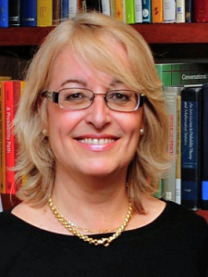AMES, Iowa – The National Institute of Standards and Technology (NIST) has awarded a five-year, up to $20 million grant to establish a Forensic Science Center of Excellence to be based at Iowa State University.
The new center, pending approval by the Iowa Board of Regents, will be the third NIST Center of Excellence and the only one focused on forensic sciences. Its primary goal will be to build a statistically sound and scientifically solid foundation under two branches of forensics, pattern evidence (including fingerprints and bullet marks) and digital evidence (including data from cell phones and computers).
“We’re proud that Iowa State is leading this new national center,” said Iowa State President Steven Leath. “This center will do important scientific research for the country’s law enforcement and criminal justice systems. This is one more example of Iowa State researchers working to meet today’s biggest challenges.”
Alicia Carriquiry, an Iowa State statistician and Distinguished Professor in Liberal Arts and Sciences, will lead the center. The center will also include researchers from Carnegie Mellon University in Pittsburgh, the University of California, Irvine and the University of Virginia.
“We are tremendously honored and excited for the award” Carriquiry said. “Once NIST announced the terms of the competition, it became clear to us that assembling a strong team of statisticians with an interest in forensic sciences was exactly the right strategy. We look forward to collaborating with NIST, with forensic and basic scientists and with practitioners in the United States and abroad, and to contribute to the fair administration of justice.”
Other leaders of the center are David Baldwin, director of the Midwest Forensics Research Center at Iowa State and adjunct associate professor of chemistry; Stephen Fienberg, the Maurice Falk University Professor of Statistics and Social Science at Carnegie Mellon; Karen Kafadar, Commonwealth Professor and Chair of Statistics at Virginia; and Hal Stern, the Ted and Janice Smith Family Foundation Dean of the Donald Bren School of Information and Computer Sciences and professor of statistics at UC Irvine.
A 2009 report by the National Research Council, “Strengthening Forensic Science in the United States: A Path Forward,” found serious problems with the country’s forensic science system and called for major reforms and new research. With the exception of DNA analysis, the report said forensic methods needed substantial research to validate techniques, assess limitations and discover the sources of errors.
To address those problems, the report recommended establishment of a national forensics institute to lead research, establish standards and oversee education.
“Much research is needed not only to evaluate the reliability and accuracy of current forensic methods but also to innovate and develop them further,” said Constantine Gatsonis, the director of the Center for Statistical Sciences at Brown University and a co-chair of the committee that authored the report, speaking at the time the report was released. “An organized and well-supported research enterprise is a key requirement for carrying this out.”
Carriquiry said the main focus of the new Forensic Science Center of Excellence will be on the empirical and statistical foundation for various forms of pattern and digital evidence. She said center researchers hope to collaborate with NIST and with the forensic community as well as with the broader scientific community.
“Iowa State’s strength in statistics and our tradition of collaboration across disciplines will be critically important for the success of this enterprise,” she said.
In addition to its scientific work, the new center will also address forensics training and education. Carriquiry said judges, lawyers, forensic examiners and students all need a better understanding of statistical analysis and interpretation of forensic evidence.
Forensic science really is more complicated than the TV shows, Carriquiry said.
“Popular programs such as ‘CSI,’” she said, “have contributed to the mistaken belief that identifying a single source for the evidence requires only that the scientist can establish a match between the evidence and the potential source.”
